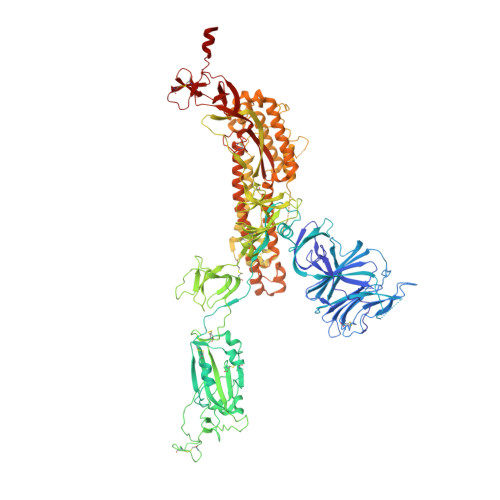Broadly potent spike-specific human monoclonal antibodies inhibit SARS-CoV-2 Omicron sub-lineages.
Walker, M.R., Underwood, A., Bjornsson, K.H., Raghavan, S.S.R., Bassi, M.R., Binderup, A., Pham, L.V., Ramirez, S., Pinholt, M., Dagil, R., Knudsen, A.S., Idorn, M., Soegaard, M., Wang, K., Ward, A.B., Salanti, A., Bukh, J., Barfod, L.(2024) Commun Biol 7: 1239-1239
- PubMed: 39354108
- DOI: https://doi.org/10.1038/s42003-024-06951-7
- Primary Citation of Related Structures:
8C5R, 9FJK - PubMed Abstract:
The continuous emergence of SARS-CoV-2 variants of concern has rendered many therapeutic monoclonal antibodies (mAbs) ineffective. To date, there are no clinically authorized therapeutic antibodies effective against the recently circulating Omicron sub-lineages BA.2.86 and JN.1. Here, we report the isolation of broad and potent neutralizing human mAbs (HuMabs) from a healthcare worker infected with SARS-CoV-2 early in the pandemic. These include a genetically unique HuMab, named K501SP6, which can neutralize different Omicron sub-lineages, including BQ.1, XBB.1, BA.2.86 and JN.1, by targeting a highly conserved epitope on the N terminal domain, as well as an RBD-specific HuMab (K501SP3) with high potency towards earlier circulating variants that was escaped by the more recent Omicron sub-lineages through spike F486 and E484 substitutions. Characterizing SARS-CoV-2 spike-specific HuMabs, including broadly reactive non-RBD-specific HuMabs, can give insight into the immune mechanisms involved in neutralization and immune evasion, which can be a valuable addition to already existing SARS-CoV-2 therapies.
- Centre for Translational Medicine and Parasitology, Department of Immunology and Microbiology, Faculty of Health and Medical Sciences, University of Copenhagen, Copenhagen, Denmark.
Organizational Affiliation:
















